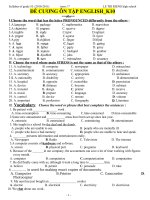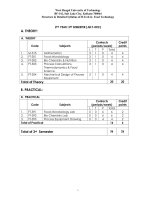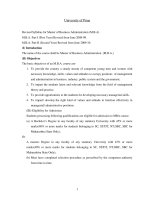Crystals syllabus
Bạn đang xem bản rút gọn của tài liệu. Xem và tải ngay bản đầy đủ của tài liệu tại đây (220.24 KB, 13 trang )
Crystals Syllabus
1.
2.
3.
4.
5.
Crystalline solids are based upon a simple pattern of arrangements of
atoms that is repeated many times throughout the molecules. The
atoms or the groups of atoms are arranged in a regular order.
The order is so regular that knowing the arrangement at one point
the arrangement at other site can be predicted. This is called long
range order.
Crystals are anisotropic in nature i.e they have different physical
properties in different directions.
They are incompressible have a definite melting point so they pass
rather sharply from solid to liquid state.
The Crystalline solids can be divided into two categories.
single crystalline(the regular order extended over the whole
crystal) and polycrystalline (the regular order extend over a small
range).
Crystal lattice or Space lattice
• A lattice is a regular array of points showing
how molecules, atoms and ions are arranged
in space.
Unit Cell
• The smallest three dimensional portion of a
complete space lattice which when repeated
over and again in different directions
produces the complete space lattice.
Crystal structure= lattice + basis
• The lattice is an orderly arrangement of point
in space while the basis consists of simplest
arrangement of atoms which is repeated at
every points to build up the crystal structure
Types of unit cells.
• If we take into consideration, the symmetry of
the axial distances (a,b,c) and also the axial
angles between the edges (α,β,γ) the various
crystals can be divided into seven systems.
These are called crystal habits.
NO.
Crystals
Axial distance
Axial angles
Examples
1
Cubic
a=b=c
α=β=γ=90◦
NaCl, KCl,
Diamond
2
Tetragonal
a=b not equal to c
α=β=γ=90◦
White tin, SnO2
3
Orthorhombic
All distances are
unequal
α=β=γ=90◦
Rhombic sulphur,
KNO3, BaSO4
4
Rhombohedral
a=b=c
α=β=γ not equal
to 90◦
Calcite, quartz,
NaNO3
5
Hexagonal
a=b=c
α=β=90◦ γ=120◦
ZnO, CdS
6
Monoclinic
All distances are
unequal
α=β=90◦ but γ is
different
Monoclinic
sulphur,
Na2SO4.10H2O
7
Triclinic
All distances are
unequal
All angles are
different and not
equal to 90◦
Blue Vitriol,
K2Cr2O7
• Unit cells can also be further classified as Primitive or Simple unit
cell : The unit cells at which lattice points are present only at the
corners of the unit cell.
• Non primitive unit cell : The unit cell in which the lattice points are
not only present at the corners of the unit cell but also at some
other places are called non primitive unit cells. It is divided into
following categories
• A) Face centred
• B) End face centred
• C) Body centred
•
Body-centered cubic (I)
Body centred
Face centred
Crystal structure of Sodium Chloride
Sodium Chloride Crystal structure
• In NaCl each ion is surrounded by six ions of
opposite charge.
• The surrounding atoms are located at the
vertices of a regular octahedron.
• This is also called rocksalt crystal structure.
• It can be represented as a FCC lattice with two
atoms basis or as two interpenetrating FCC
lattices.
Crystal Structure of Zinc Sulphide (ZnS)
• ZnS exists in two main crystalline forms, and this dualism is often
a salient example of polymorphism.
• In both polymorphism, the coordination geometry at Zn and S are
tetrahedral.
• The more stable cubic form is known also as zinc blende or
sphalerite. The hexagonal form is known as the mineral wurtzite.
• If the sulfide ions originally adopt a hexagonal closest-packed
structure, the ZnS crystal is wurtzite. If the sulfide ions originally
adopt a cubic closest-packed structure, the ZnS crystal is zinc
blende.
Zinc Blende or Sphalerite
Wurzite
NaCl crystal structure.









